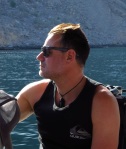In the previous blog I wrote how I joined a great team of researchers to study fish diversity in Oman. The scientists I’m working with are experts in their fields, and form a very complimentary group, perfect to be studying fish diversity with. It’s fantastic to be collaborating with them, especially since this kind of work is new to me, which means I am learning loads at the moment! So it’s only fair to introduce the people that are really driving this trip.
Ms. Amanda Hay: Amanda is Acting Ichthyology Collection Manager at the Australian Museum. She is a taxonomy expert, specialised in larval fishes. While she considers herself a jack-of-all-trades, she is the most organised member of the team who makes sure all the fish are named and catalogued properly.

Dr. Chris Goatley: Chris is a postdoctoral research fellow at University of New England who specialises in reef fish ecology. In particular, Chris is interested in the ecology of the smallest coral reef fishes, including gobies and blennies. He is particularly interested in the roles of these small fishes in maintaining coral reef food webs.
 Dr. Darren Coker: Darren is a Research Scientist in the Red Sea Research Center and Saudi Aramco-KAUST center for Marine Environmental Observations at King Abdullah University of Science and Technology in Saudi Arabia. Here he focuses on reef fish communities along environmental gradients and how local and global stresses influence fish groups that are important to reef health.
Dr. Darren Coker: Darren is a Research Scientist in the Red Sea Research Center and Saudi Aramco-KAUST center for Marine Environmental Observations at King Abdullah University of Science and Technology in Saudi Arabia. Here he focuses on reef fish communities along environmental gradients and how local and global stresses influence fish groups that are important to reef health.
 Dr. Alyssa Marshell: Alyssa is an Assistant Professor in the College of Agricultural and Marine Sciences at Sultan Qaboos University. She is on of the lead investigators on the DFAT CAAR grant that funds this research project. Alyssa is an expert in marine and spatial ecology, with particular interests in the movement and behaviour of herbivorous reef fishes.
Dr. Alyssa Marshell: Alyssa is an Assistant Professor in the College of Agricultural and Marine Sciences at Sultan Qaboos University. She is on of the lead investigators on the DFAT CAAR grant that funds this research project. Alyssa is an expert in marine and spatial ecology, with particular interests in the movement and behaviour of herbivorous reef fishes.
 Dr. Joey DiBattista: Joey is the new Curator of Ichthyology at the Australian Museum and standing member of the TrEnD Lab at Curtin University. Joey is the other lead investigator on this research project. His name might sound familiar if you follow this blog, since he has written a very interesting guest blog in the past. Joey is interested in developing next generation-sequencing tools to aid in fisheries management. His new position role at the museum will allow him to build up genetic “barcode” libraries for fishes across Australia.
Dr. Joey DiBattista: Joey is the new Curator of Ichthyology at the Australian Museum and standing member of the TrEnD Lab at Curtin University. Joey is the other lead investigator on this research project. His name might sound familiar if you follow this blog, since he has written a very interesting guest blog in the past. Joey is interested in developing next generation-sequencing tools to aid in fisheries management. His new position role at the museum will allow him to build up genetic “barcode” libraries for fishes across Australia.
These are not the only team members working on this project, other researchers involved include remote marine field specialist Tane Sinclair-Taylor, PhD student Mark Priest, and Director of the Red Sea Research Center at KAUST – Professor Michael Berumen. Their contribution is at least as important as the other members, but they are unfortunately not close enough at the moment to hassle them for info.
Lastly, the newest, honorary member of the team is our Musandam captain Ali! Ali owns Ras Mudandam Diver, the dive centre that was taking us out for our work here. He’s been an absolute legend, and if you’re considering diving here, you should definitely look him up!

Captain Ali

Pingback: Marine biodiversity in Oman: Mini-blog 3 – Workshop time | Critter Research